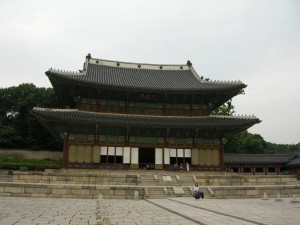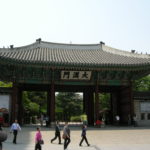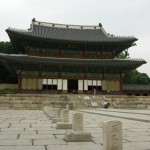
The National Treasures of South Korea are a numbered set of treasures, artifacts, sites, and buildings which are recognized by South Korea as having exceptional artistic, cultural heritage and historical value. Currently there are 315 National treasures. The Cultural Heritage Administration of [...]]]>

Changdeokgung Palace
The National Treasures of South Korea are a numbered set of treasures, artifacts, sites, and buildings which are recognized by South Korea as having exceptional artistic, cultural heritage and historical value. Currently there are 315 National treasures. The Cultural Heritage Administration of Korea monitor, decide and protect the National Treasures. The treasures are numbered according to the order in which they were designated not according to their individual value.
On February 10th, 2008 National Treasure No. 1 was destroyed. Namdaemun Gate which was designated as the first National Treasure of Korea on December 20th, 1962 was destroyed by an arson attack.
Injeongjeon Hall in Changdeokgung Palace, Seoul was designated as National Treasure No. 226 on Janurary the 8th, 1985. Injeongjeon is the throne, which was used for holding the most formal of state events such as audiences with ministers, coronation ceremonies and receptions of foreign envoys. The plum blossom pattern on the roof was added in 1897 to symbolise the imperial status of the Great Han Empire.
Injeongjeon Hall is located in Changdeok Palace.
Admission:
Changdeokgung Palace
Adults : 3,000won
Children : 1,500won
Opening hours:
April – October 09:00 – 18:30
March & November 09:00~17:30
December – February 09:00~17:00
How to get Chandeok Palace:
There are many subway stations located nearby. Check the map for your best route.
- From Exit #3 of Anguk Subway Station (Seoul Subway Line No. 3), walk 5 minutes.
- From Exit #6 of Jongno 3-ga Subway Station (Seoul Subway Line No. 1, 3 and 5), walk 10 minutes.
View larger map








 ]]>
]]>

Deoksugung Palace is one of the five palaces from the Jeseon Dynasty which lasted over 500 years. Deoksugung was originally built as a residence for Prince Wolsan, the elder brother of King Seongjong (1469-1494). After all other palace buildings were destroyed by fire during the Japanese invasion of 1592, King Seonjo (1567-1608) established a temporary [...]]]>

Deoksugung Palace Entrance
Deoksugung Palace is one of the five palaces from the Jeseon Dynasty which lasted over 500 years. Deoksugung was originally built as a residence for Prince Wolsan, the elder brother of King Seongjong (1469-1494). After all other palace buildings were destroyed by fire during the Japanese invasion of 1592, King Seonjo (1567-1608) established a temporary residence here. King Gwanghaegun (1608-1623), who succeeded King Seonjo, named the palace Gyeongungung in 1611. King Injo (1623-1649) held a coronation ceremony in Jeukjodang Hall in 1623. It was here in 1897 that King Gojong proclaimed to the nation and the world the establishment of the “Great Han Empire”. The palace was renamed Deoksugung in 1907, when King Sunjong ascended the throne and it has been known by that name to this day. In 2007 a major restoration project was undertaken.
The palace was 3 times larger than it is today, encompassing the whole area around the present city hall, Seoul Plaza and Jeong-dong area. As foreign diplomats and missionaries arrived in Seoul, some western-style buildings also appeared inside Deoksugung palace.
Although located in the busy centre of Seoul, Deoksugung is very tranquil. On first arriving at Deoksugung palace you will see Daehanmun Gate. This is the main gate of Deoksugung Palace. A daily show of the changing of the guards can be seen here at 11:00, 14:00 and 15:30. After entering Daehanmum gate you will pass over Geumcheongyo bridge. After heading straight you will come to Junghwa Gate and Junghwajeon. All of the official affairs took place in this building and meetings with foreign convoys. This is the main building in Deoksugung Palace. Originally it was two stories high and a wall was built around it. Now it stands at one story and the wall is gone, leaving the Junghwa gate pointless.
At the far end of this small palace we can find Seokjojeon Hall, which means stone house. This was built to add a more western feel to the palace at the start of the 20th century. It was designed by British architect G.R Harding. The building was rarely used as most westerners were kicked out of Korea by the Japanese after they won the Russo-Japanese war. Eventually the Japanese turned it into an art gallery. After gaining independence in 1945 the building was used to hold talks between America and the Soviets. After the Korean war it became the National Museum of Korea until 1986. The building is still undergoing restoration.
Also inside Deoksugung Palace you can find a statue of Sejong The Great. For more information about Sejong click here.
Admission / Opening Hours:
Open from 09:00 to 21:00 and closed every Monday. Tickets stop going on sale one hour before closing.
Adults: 1,000 WON
Children: 500 WON
How to get to Deoksugung Palace:
Take line one to City Hall Station and leave exit 2 or Take line two to City Hall Station and leave exit 12. With both stations you can’t miss the palace when you leave the exits.
View larger map








 ]]>
]]>

Changdeokgung Palace is one of the five palaces built by the kings of the Joseon Dynasty. Construction of Changdeokgung Palace started in 1405, and was completed in 1412. The palace was destroyed during the Japanese invasion of 1592 and then reconstructed in 1610. Tragedy struck again in 1623 when the palace was set on fire by [...]]]>

Changdeokgung Palace
Changdeokgung Palace is one of the five palaces built by the kings of the Joseon Dynasty. Construction of Changdeokgung Palace started in 1405, and was completed in 1412. The palace was destroyed during the Japanese invasion of 1592 and then reconstructed in 1610. Tragedy struck again in 1623 when the palace was set on fire by Korean citizens revolting against the king. The palace was yet again restored and continued to be plagued by problems and fire over the next few hundred years. Finally from 1990 – 1999 large-scale restoration work began. In 1997 Changdeokgung Palace UNESCO list Changdeokgung Palace as a world heritage site. Unesco stated the reason for adding it to the list was for it’s outstanding architecture and a design that is in harmony with the landscape.
At Changdeokgung Palace there are things to see such as Donhwamun Gate, Geumcheongyo Bridge – Oldest bridge still in existence in Seoul, built 1411 and Injeongjeon Hall . However the main attraction, in my opinion, is the Biwon( Secret Garden). Being a 72-acre garden it wasn’t an easy secret to hide. The King spent a lot of his time here thinking and many high officials would not dare enter the garden without his permission. In the garden there a hundreds of different species of trees dating back over 300 years. The garden also incorporates a lotus pond, a pavilion and landscaped lawns , trees and plants.
It takes about 2 and a half hours to stroll around the palace and gardens.
Admission:
Changdeokgung Palace
Adults : 3,000won
Children : 1,500won
Secret Garden;
Adults: 5,000won
Children: 2,500won
Opening hours:
April – October 09:00 – 18:30
March & November 09:00~17:30
December – February 09:00~17:00
How to get to Changdeokgung Palace:
There are many subway stations located nearby. Check the map for your best route.
- From Exit #3 of Anguk Subway Station (Seoul Subway Line No. 3), walk 5 minutes.
- From Exit #6 of Jongno 3-ga Subway Station (Seoul Subway Line No. 1, 3 and 5), walk 10 minutes.
View larger map








 ]]>
]]>